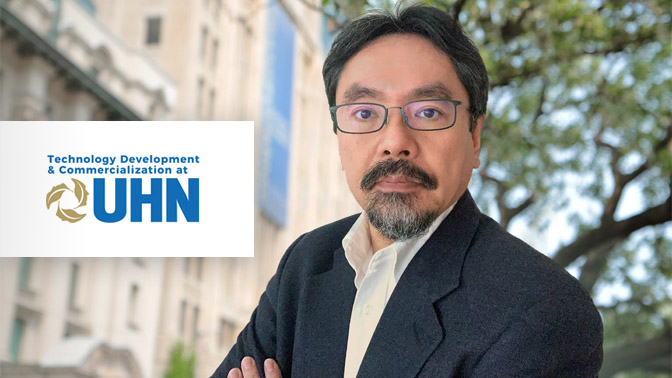
The Technology and Commercialization (TDC) office is thrilled to recognize Dr. Naoto Hirano, Senior Scientist at Princess Margaret Cancer Centre, as the winner of UHN’s 17th annual Inventor of the Year Award.
Dr. Naoto Hirano received the award for his work on developing the TCR-HLA multimer staining technique, which greatly expands how immunotherapy targets cancer, allowing more people to benefit from the treatment.
The TCR-HLA multimer staining technology is part of a branch of cancer immunotherapy known as T-cell receptor-based adoptive cellular therapy, which helps to stimulate the body’s own immune response to destroy cancer cells.
The approach devised by Dr. Hirano overcomes current immunotherapy targeting limitations that arise from using only a few types of human leukocyte antigens (HLA) during immunotherapy. HLAs are responsible for presenting antigenic peptides to the body in order to stimulate an immune response. The types of HLAs currently available are only found in a small subset of people and ethnic groups. Furthermore, only a select number of peptides, which are present in a fraction of the cancer cells, are used.
TCR-HLA multimer staining enables a wide variety of different types of HLAs and peptides to be used to target cancer. These can be customized to individual patients, greatly expanding the effectiveness and applicability of immunotherapies.
Dr. Hirano is also the scientific co-founder of TCRyption Inc., a UHN spin-off company that was recently launched to help advance T-cell immunotherapy using this groundbreaking technology. TCRyption Inc.’s commercialization efforts were led by UHN’s TDC, which secured an initial $10 million in seed financing to advance the innovation towards helping patients.
“We are thrilled to recognize the world-class science, collaboration and commercialization that Dr. Naoto Hirano exemplifies. It is exciting to see another UHN and Toronto ecosystem technology making bold strides towards improving health by including a broader spectrum of patients in need,” says Brad Wouters, Executive Vice President, Science and Research, UHN.
Congratulations, Dr. Hirano!
About the Inventor of the Year Award
The Inventor of the Year Award is an annual award recognizing UHN researchers who have demonstrated excellence in translating their findings into new technologies, services and products that improve health. These inventions, along with the many other cutting-edge research innovations made at UHN, demonstrate the world-class creativity and impact that UHN researchers are having on the global health care community.
Past Inventor of the Year winners include:
- Drs. Shaf Keshavjee and Marcelo Cypel (2018) for their pioneering work in developing the Toronto Ex Vivo Lung Perfusion (EVLP) system
- Drs. Gordon Keller and Michael Laflamme (2017) for their pioneering research and study of stem cells and inventiveness in the field of regenerative medicine
- Dr. Christopher Paige (2016) for his work in immune-oncology and developing a therapeutic approach that uses a patient's own immune system to fight cancer
- Drs. Hisham Alshaer, T. Douglas Bradley and Geoff Fernie (2015) for developing BresoDx®, a device that can be used to diagnose sleep apnea at home
- Dr. Milos Popovic (2014) for his ground-breaking neurorehabilitation research, which led to the creation of a new product called MyndMove™
- Dr. Tak Mak and The Campbell Family Institute for Breast Cancer Research Therapeutics Group (2013) for the team's creation and development of a first-in-class cancer therapeutic (CFI-400945), and the further achievement of a successful IND and associated launch of a clinical trial
- Dr. Ralph DaCosta (2013) for his development of a hand-held fluorescence imaging device for real-time wound care monitoring and assessment, and its ongoing successful commercialization through the creation of the company MolecuLight Inc.
- Dr. Thomas Purdie (2012) for his role in developing software that has significantly improved the way cancer radiation therapy is delivered
- Dr. Aaron Schimmer (2011) for pioneering work in the area of re-positioning anti-infective drugs for the treatment of leukemia
- Dr. Gang Zheng (2010) for his work in the development of novel nanoparticle formulations, which have enabled new therapeutic approaches to the treatment of cancer
- Drs. Mohammad Islam and Michael Sharpe (2009) for their inventions, which make radiation therapy safer, more effective and more efficient
- Drs. Ming-Sound Tsao, Frances A. Shepherd, and Igor Jurisica (2008) for developing ground-breaking prognostic genomic analysis for early stage non-small-cell lung cancer
- Dr. David Jaffray (2007) for his creativity in applying cutting-edge physics and engineering to the integration of imaging and radiation therapy in the cancer clinic
- Dr. Andres Lozano (2006) for his ingenuity in using deep brain stimulation—a technology that selectively modifies neurotransmission activity-- to treat depression, anxiety, cognitive disorders and Parkinson's disease
- Dr. Joe Fisher (2005) for his invention of many exciting medical technologies including a non-invasive system to measure heart health, a portable device that allows the rapid treatment of carbon monoxide poisoning and an oxygen delivery mask that can help prevent spread of respiratory diseases such as SARS or Avian Influenza in hospitals
- Dr. Dan Drucker (2004) for inventions targeted towards treating patients with diabetes, short bowel syndrome and Crohn's disease. A number of these products have already reached Phase II or III clinical trials, or are awaiting FDA approval
- Dr. Kevin Kain (2003) for his discovery of new medications for the treatment of malaria, including a treatment for the most severe and frequently fatal form of the disease




